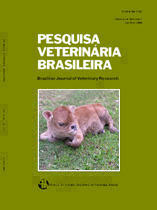 |
|
|
|
Year 2013 - Volume 33, Number 10
|

|
Biochemical, electrolytic and hormonal findings in goats affected with pregnancy toxemia, 33(10):1174-1182
|
ABSTRACT.- Souto R.J.C., Afonso J.A.B., Mendonça C.L., Carvalho C.C.D., Alonso P. Silva Filho., Cajueiro, F.P., Lima E.H.F. & Soares P.C. 2013. [Biochemical, electrolytic and hormonal findings in goats affected with pregnancy toxemia.] Achados bioquímicos, eletrolíticos e hormonais em cabras acometidas com toxemia da prenhez. Pesquisa Veterinária Brasileira 33(10):1174-1182. Clínica de Bovinos, Campus Garanhuns, Universidade Federal Rural de Pernambuco, Av. Bom Pastor s/n, Cx. Postal 152, Boa Vista, Garanhuns, PE 55292-270, Brazil. E-mail: afonsojab@oi.com.br
Studies on pregnancy toxemia (PT) have been constant and innovative with regard to some concepts. However, no studies have been carried out on natural clinical cases in Brazil. Thus, the aim of the present study was to perform an analysis of clinical, biochemical, electrolytic and hormonal findings in goats with PT to gain an understanding of the physiopathology of this metabolic disease. Twenty-two goats with a diagnosis of PT were analyzed at the Bovine Clinic of the Federal Rural University of Pernambuco (Garanhuns Campus, Brazil) between 2007 and 2012. Clinical exams were performed and both blood and urine were collected for the biochemical and hormonal analyses. Accentuated clinical changes were found, such as decubitus, apathy, dyspnea, increased body temperature, congested mucous membranes, dilated episcleral vessels, dehydration, anorexia, ruminal stasis and edema in the limbs. The laboratory findings revealed high concentrations of urea, creatinine, non-esterified fatty acids, β-hydroxybutyrate, amylase and cortisol as well as reductions in total proteins, albumin, total calcium, ionized calcium, phosphorus the calcium to phosphorus ratio, sodium and insulin. Fructosamine, globulin, chlorine, potassium and magnesium were within the range of normality. Regarding blood sugar, 50% of the goats were within the normal range, 27.28% were hyperglycemic and 22.72% were hypoglycemic; among the 17 animals (77.27%) discharged with life, ten (58.82%) had normal blood sugar levels. Five goats (22.8%) died, 60% (3/5) of which were hyperglycemic. The mean birth rate per goat was more than two offspring. Non-esterified fatty acids were strongly associated with albumin (r = 0.60) and weakly associated with both β-hydroxybutyrate (r=0.10) and glucose (r=0.03). Moreover, non-esterified fatty acids were negatively associated with insulin (r= -0.70; strong association), cortisol (r= -0.52; moderate association) and amylase (r= -0.30; moderate association). Striking clinical and metabolic alterations are found in goats with PT. The increase in certain metabolites of the energy and hormonal profile constitutes an important tool for the diagnosis and determination of the magnitude of the clinical condition in affected animals. The present data can serve as reference for future studies on nutrition and metabolism in goats with pregnancy toxemia. |
| |
|
|
| |
|
 |